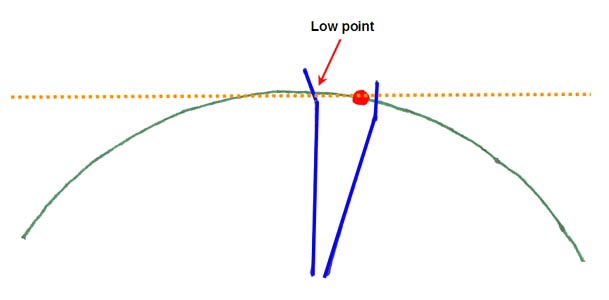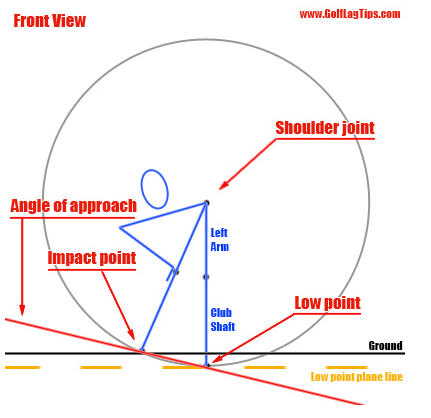To first understand it, we need to understand that the clubhead moves on an arc path on the downswing. Ever hear of an 'arced' putting stroke? Well, that's the same principle with the full swing. Here's a pic from Jeff Mann's Web site illustrating this point.

It actually does not matter if a golfer hits a hook or a slice, the clubhead will move on an arc. An 'over the top' (outside-to-inside) move will look like this.

An 'inside-to-out' swing will look like this.

In Part I of my TGM Basics post, I went over the 'Geometry of the Circle.' This is the circle that the clubhead travels on when viewing a golfer from the face on viewpoint. Here again is that diagram of the Geometry of the Circle.
 So, the clubhead now has 3-dimensional motions. From the 'overhead' view the clubhead moves on an arc. From the 'face on' view the clubhead moves in a circle. And then there's the DTL view.
So, the clubhead now has 3-dimensional motions. From the 'overhead' view the clubhead moves on an arc. From the 'face on' view the clubhead moves in a circle. And then there's the DTL view.To start, the proper 3-dimensional motion of the clubhead thru impact is known as 'DOWN, OUT, and FORWARD.'
Repeat that again.
DOWN
OUT
FORWARD
And the big part is that this is the motion THRU impact.
When looking at the Geometry of the Circle Diagram, you will see that a properly executed swing will have the 'low point' opposite of the golfer's left shoulder. That means that if the swing is properly executed, the clubhead will reached it's lowest point at a spot that is opposite of the golfer's left shoulder. Because we place the ball in the middle of the stance which is behind the low point, that's why when we hit an iron we are supposed to hit the ball FIRST ---- THEN take a divot. So much so that the divot winds up being IN FRONT of where the ball used to be.
In order to do this, the clubhead on the downswing comes down at the ball with a descending angle of attack. It then hits the ball and then goes DOWN even more.
So that's where the first part of the phrase 'Down, Out and Forward' comes from. Once the ball is hit by the club, the clubhead needs to go downward.
Now, when it comes to the driver it's a bit different. Trackman has found that in order to optimize distance with a driver a golfer needs to hit slightly upward on the ball. However, the Geometry stays the same. The golfer just needs to move the ball further up in their stance (and teeing it up higher helps as well). Essentially, if the golfer wants to optimize their distance with a driver, they just move the ball closer to the 'low point' in the Geometry of the Circle.
Lynn Blake has often said that getting the DOWN part of the 3-dimensional impact is the toughest part for golfers to execute.
The next term is 'OUT.' Let's look at Jeff Mann's diagram of the clubhead moving on an arc from the up top view.

Pay close attention to the impact and low point parts of the diagram drawn by Mann. If you notice the clubhead hits the ball and at about the low point (which again, is a point that comes AFTER the ball has been struck) the clubhead path is actually slightly outside the red dotted plane line.
This is NOT an 'in-to-out' path. This is actually an 'in-square-in' path. That's because according to Homer Kelley in The Golfing Machine, the clubhead must go outward to a degree after making contact with the ball. That's what usually all of this 'swinging out to right field' stuff you may hear is about. It's often because the golfer does not get the clubhead 'out' enough.
And the forward part is pretty simple. That's just the golfer going from their impact to their finish position. Most golfers have no problem with the forward part.
The problem that golfers do tend to have is that they have a 3-dimensional impact motion of UP, IN and FORWARD instead of DOWN, OUT and FORWARD. Or they'll go down, but they won't catch the ball FIRST and THEN go down. They'll catch the turf first and then go down.
REVIEW
1. Impact is 3-dimensional, known as DOWN, OUT and then FORWARD
2. From the above view, the clubhead moves on an arc.
3. From the Face On view, the clubhead moves in a circle.
4. Ball Should be struck FIRST and then the clubhead will go DOWN even more and take a divot. The divot should be IN FRONT OF where the ball used to be. With a driver, the geometry of the circle stays the same, but the golfer may move the ball further up in their stance.
5. After the ball is struck, the clubhead should go 'outside' of the plane line to some degree.
6. Forward is the clubhead going from impact to finish.
7. Most golfers tend to go 'up, in and forward' instead of 'DOWN, OUT and FORWARD.'
8. Most golfers do not understand that you need to hit the ball FIRST. Golfer who do go DOWN, tend to mistakenly think that you hit the turf first and this causes fat shots.
Up Next, 'Hitters' vs. 'Swingers'
3JACK
2 comments:
Richie,
After your swinging left post I was worried about you, now you're right back on track. :-)
Great post 3Jack!
Kevin
Yeah, I'm not so sure on 'swinging left' just yet. I do think that golfers need to get the basics down first before they start worrying about stuff like that. If you're over the top and/or flipping, you can swing left all you want, but you ain't hitting the ball very well and need to concentrate on getting a FLW and getting on plane on the downswing.
Post a Comment